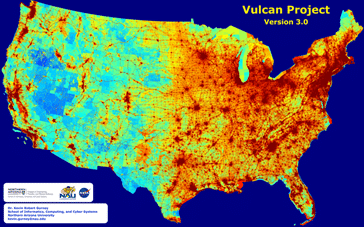Oct 6 2020
The fierce and frequent hurricanes in the Gulf of Mexico and the intense wildfires in the Western United States have devastated the country again. Such extreme weather-related events are the result of climate change.
 Emissions map of the entire U.S. landscape at high space—and time-resolution with details on the economic sector, fuel, and combustion process. Image Credit: Northern Arizona University.
Emissions map of the entire U.S. landscape at high space—and time-resolution with details on the economic sector, fuel, and combustion process. Image Credit: Northern Arizona University.
In response to these events, regions, states, and cities across the nation are developing policies to decrease their emissions of greenhouse gases, mainly carbon dioxide (CO2). Although several local and state governments are dedicated to these objectives, the emissions data they have to work with is too costly and too general to offer a beneficial baseline and focus on the most effective policy.
Professor Kevin Gurney from the School of Informatics, Computing, and Cyber Systems at Northern Arizona University has recently published the results of the study in the Journal of Geophysical Research, describing greenhouse gas emissions throughout the entire U.S. landscape at high space- and time-resolution with information on the economic industry, combustion process, and fuel.
Gurney, who is also an expert in atmospheric science, ecology, and public policy, has been developing a standardized system in the last several years. Part of the Vulcan Project, the system visualizes and measures greenhouse gases that are discharged across the entire nation down to individual power plants, roadways, and neighborhoods, detecting problem regions and allowing better decisions regarding where to reduce emissions most effectively.
As a follow-up to the countrywide research, Gurney generated emissions maps of many different large cities, such as Indianapolis, the Los Angeles megacity, Salt Lake City, Utah, and the Washington, D.C./Baltimore metropolitan area.
Financially supported by NASA, Gurney created the high-resolution emissions map to serve as an effective tool for policy and scientific applications. Gurney’s aim is to provide a new way to nation-wide policymakers that would allow them to strategically deal with the problem regions rather than take an expensive and inefficient method.
We’re providing U.S. policymakers at national, state and local scales with a scalpel instead of a hammer. Policies that might be relevant to California are possibly less relevant for Chicago or New York. They need to have information that reflects their unique conditions but follows a rigorous, standardized scientific approach. In this way, they can have confidence in the numbers which, in turn, will stimulate smart investment in reducing emissions.
Kevin Gurney, Professor, School of Informatics, Computing, and Cyber Systems, Northern Arizona University
Validation by atmospheric monitoring of CO2 from satellite and ground-based instruments is one of the strengths of Gurney’s method.
By synthesizing the detail of building and road-scale emissions with the independence and accuracy of atmospheric monitoring, we have the best possible estimate of emissions with the most policy-relevant detail.
Kevin Gurney, Professor, School of Informatics, Computing, and Cyber Systems, Northern Arizona University
By characterizing CO2 emissions across the U.S. landscape from coast to coast, the system provides an inventory on emissions to each U.S. city, emphasized Gurney.
By extracting all cities in the U.S. from our data product, we can offer every city a consistent and comprehensive assessment of their emissions. Like the U.S. weather forecasting system, this problem is best solved with a single systemic approach and shared with city stakeholders so they can do what they know how to do better than anyone—reduce emissions in ways that meet their individual need.
Kevin Gurney, Professor, School of Informatics, Computing, and Cyber Systems, Northern Arizona University
The information from the Vulcan mapping project is available on the Oak Ridge National Laboratory Data Archive. More imagery is available on the Vulcan website.
The study was performed through financial support from the National Aeronautics and Space Administration grant NNX14AJ20G and the NASA Carbon Monitoring System program, Understanding User Needs for Carbon Information project (subcontract 1491755).
Journal Reference
Gurney, K. R., et al. (2020) The Vulcan Version 3.0 High-Resolution Fossil Fuel CO2 Emissions for the United States. Journal of Geophysical Research. doi.org/10.1029/2020JD032974.